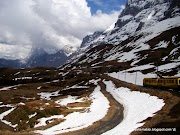The third part of my Roman Top 20, starting from #10:
A római top 20-as listám harmadik része, a 10. helytől indulva:
This may not be the most impressive Roman monument in itself but I simply love how a 2012 redesign transformed the square under which the stadium is located. Plovdiv's central square is now a super-cool place where you can sit on the stairs of the beautifully excavated ancient stadium or walk all around it while surrounded by a medieval Ottoman mosque and 19th century mansions.
Itt talán nem is maga a stadion a lényeg, hanem az, ahogyan a 2012-es átalakítás során megújult az a tér, amely alatt a stadion áll. Plovdiv központi terén körben elegáns 19. századi házakat és egy középkori oszmán mecsetet látunk, középen pedig bejárhatjuk a gyönyörűen feltárt ókori stadiont, vagy csak ülhetünk a lépcsőin és nézhetjük, hogy az egész környezet milyen menő lett.
7. POMPEII
A római top 20-as listám harmadik része, a 10. helytől indulva:
10. AQUILEIA
Italy / Olaszország
Aquileia was one of the most important cities of the Roman Empire, but the most amazing remnant of its former glory is hidden inside the Cathedral, which is "just" a thousand years old. The entire floor of the nave is covered by mosaics from the 4th century! Do I need to say more...?
 |
| Aquileia |
Bár Aquileia a Római Birodalom egyik legjelentősebb városa volt, a dicső múlt leglátványosabb emléke a Katedrálisban rejtőzik, amely "mindössze" ezer éves. Az egész főhajó padlóját 4.századi mozaikok borítják! Kell ennél több...?
 |
| Aquileia |
9. BEIT SHEAN
Israel / Izrael
Deep in the Jordan Valley a Roman town that thrived long after the Western Roman Empire had ceased to exist and survived the Arab conquests too until it was devastated by an earthquake in 749 AD. Today it has everything a visitor like me would want, including mosaics and a very well-preserved theater, but the two things I liked the most is the colonnaded main street (Cardo) and the hill rising directly behind, offering a great view of the whole site.
A Jordán-folyó völgyében van egy római város, amely még jóval a Római Birodalom nyugati részének bukása után is virágzott, ráadásul sértetlenül átvészelte az arab hódításokat is, míg aztán Kr.u.749-ben egy földrengés el nem pusztította. Ma van itt minden, ami egy hozzám hasonló turistát boldoggá tesz, többek közt mozaikok és egy kifejezeteen jó állapotú színház. A két kedvenc helyem azonban az oszlopokkal szegélyezett főutca (Cardo) és a mögötte emelkedő domb, ahonnan az egész várost be lehet látni.
 |
| Beit Shean |
 |
| Beit Shean |
8. ROMAN STADIUM / RÓMAI STADION (Plovdiv)
Bulgaria / Bulgária
This may not be the most impressive Roman monument in itself but I simply love how a 2012 redesign transformed the square under which the stadium is located. Plovdiv's central square is now a super-cool place where you can sit on the stairs of the beautifully excavated ancient stadium or walk all around it while surrounded by a medieval Ottoman mosque and 19th century mansions.
Itt talán nem is maga a stadion a lényeg, hanem az, ahogyan a 2012-es átalakítás során megújult az a tér, amely alatt a stadion áll. Plovdiv központi terén körben elegáns 19. századi házakat és egy középkori oszmán mecsetet látunk, középen pedig bejárhatjuk a gyönyörűen feltárt ókori stadiont, vagy csak ülhetünk a lépcsőin és nézhetjük, hogy az egész környezet milyen menő lett.
7. POMPEII
Italy / Olaszország
With most remnants of the Roman Empire being temples, palaces and aqueducts, Pompeii offers an extraordinary, unique and almost unrivaled look into what I often miss the most in other places: how did the people live? What were their homes like? Where did they go in their leisure time? In Pompeii, you don't need to stretch your imagination. The history of this town of 20000 ended so abruptly, there were no later reconstructions or alterations. Everything was frozen in time on that fateful day in 79AD when ash and pumice from Mt Vesuvius buried Pompeii.
Miközben a Római Birodalom emlékei főként templomok, paloták és vízvezetékek, Pompeii az a város, amely az egész világon szinte egyedülálló betekintést nyújt azokba a dolgokba, amelyekről más helyeken olyan nehéz bármit megtudni: hogyan éltek az emberek? Milyen házakban laktak? Hova jártak szabadidejükben?
Pompeii városában nem kell a képzelőerőre hagyatkozni. Annyira hirtelen ért véget a 20 ezres lakosú város története, hogy szó sem volt későbbi átépítésekről, átalakításokról. Minden abban az állapotában maradt, amelyben a végzetes napon volt Kr.u.79-ben, amikor is a Vezúv hamuja betemette a várost.
The most amazing thing is how similar everything is to a contemporary city. The street grid, the baths, the layout of the houses, the counter in the pub, the furnace in the bakery, the graffiti on the walls, the "beware of the dog" sign (albeit in a mosaic form, which is not that common anymore).
6. ROMAN AQUEDUCT / RÓMAI VÍZVEZETÉK (Segovia)
Spain / Spanyolország
When I said I loved how the Roman stadium was made part of the urban landscape of Plovdiv, I don't even know how to describe what I felt when I first saw the aqueduct in Segovia. 167 massive arches towering nearly 100 feet above the buildings in the heart of the city.
Ha menőnek neveztem azt, ahogyan a plovdivi római stadion a városkép részévé vált, akkor nem is tudom, mit mondjak arra, milyen érzés volt először meglátni a vízvezetéket Segovia központjában. 167 masszív boltív tornyosul a város épületei fölé, a vízvezeték legmagasabb pontján közel 30 méterig emelkedve.
Ha menőnek neveztem azt, ahogyan a plovdivi római stadion a városkép részévé vált, akkor nem is tudom, mit mondjak arra, milyen érzés volt először meglátni a vízvezetéket Segovia központjában. 167 masszív boltív tornyosul a város épületei fölé, a vízvezeték legmagasabb pontján közel 30 méterig emelkedve.










